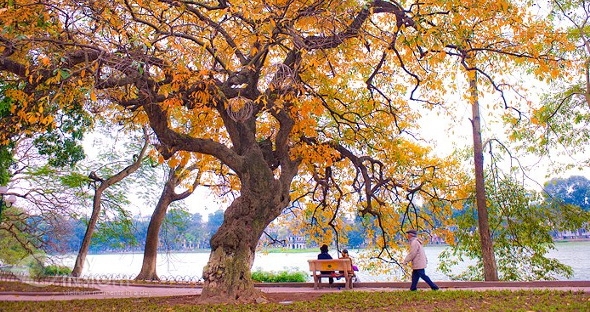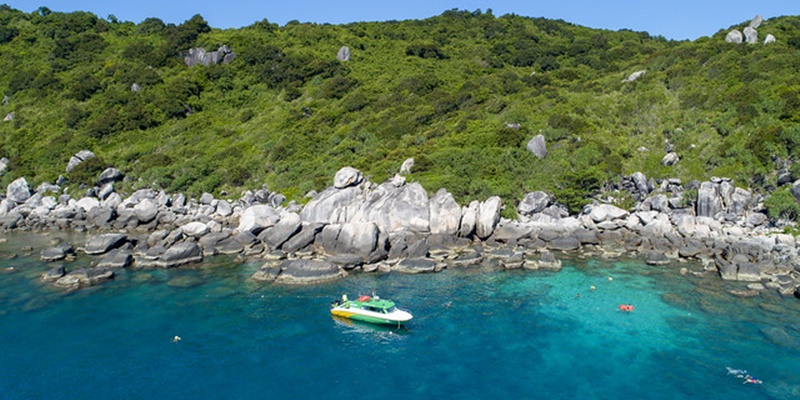With a coastline of more than 3,000 km from North to South, the Vietnamese climate varies greatly over the 15 degrees of latitude. The country has a much-diversified weather and climate, so visitors can travel to Vietnam all year. You can soak up the sun on the beaches in the Central and South and enjoy chilly cold air in the northern mountains at the same time.
North Vietnam (Hanoi, Ninh Binh, Halong Bay, Sapa)
This region has the most diverse climate patterns representing 4 distinct seasons: warm & humid spring (Feb – Apr), hot & wet summer (May – Aug), cool & breezy autumn (Sep – Nov), and chilly & dry winter (Dec – Jan). The humidity level remains around 75 – 85%, despite the variation of temperature and precipitation. While the temperatures in the summer months can reach a peak of 38°C, the winter averages may dip down to 8°C occasionally and even below zero in the mountainous north.
The best time to visit North Vietnam is spring (Mar-Apr) and autumn (Sep – Nov) when you can enjoy the best weather conditions and mesmerizing charm of the beauty spots.
Central Vietnam (Hoi An, Hue, Da Nang, Da Lat, Nha Trang)
The weather in Central Vietnam has a sharp division according to topography.
North Central (Thanh Hoa Province to Thua Thien-Hue Province)
The weather in this region is quite similar to that of the North Vietnam which is divided into 4 separate seasons. Spring and autumn here swiftly pass while summer lasts long and the temperature is high due to the influence of westerly wind. Because of direct northeasterly wind, in the winter, it is quite cold and dry here (the average temperature in January can decrease to 18°C).
South Central (Danang City to Binh Thuan Province)
The monsoon tropical climate divides this area into the rainy and dry seasons clearly. The rainy season starts in May and ends in October. When there are a lot of rains and even storms, the average rainfall in these months can reach 1,600-2000mm. In contrast, the dry season (November to April) is characterized by hot weather, continuous wind blows and prolonged drought in which the rainfall is, on average, below 200mm while the average temperature is higher, from 24 – 28°C.
The Central Highland (including the provinces of Kon Tum, Gia Lai, Dak Lak, Dak Nong and Lam Dong)
With an altitude of 500-600m above sea level, there are also two seasons in the Central Highland of Vietnam: dry season & rainy season. The rainy season takes place from May to October, and the dry season from November to April next year. The dry season is hot, drought, lack of water seriously, the rainy season is hot and humid, concentrating about 85-90% of the annual rainfall. The highland land is full of wind, rich and diversified products of the Central Highlands.
The best time to visit Central Vietnam is from March to May, the driest months with calm weather and pleasant temperatures.
South Weather (Phu Quoc, Con Dao, Ho Chi Minh City, Mekong Delta)
The southern part features the most typical monsoon climate with year-round high temperatures and constant sunshine. The southern Vietnam temperatures vary constantly around 25°C – 35°C throughout the year. In particular, there are two distinct seasons: the dry (Nov – Apr) and the wet (May-Oct), also called the rainy season.
The best time to visit South Vietnam is in the dry season, especially from December to February.
Con Dao Islands
The Con Dao Islands have a tropical monsoon climate with two seasons in the year. The dry season is from November or December to April and the rainy season is from May to October or November. The wind during the rainy season is southwest wind. The main rain in the dry season is the northeast monsoon.
Con Dao Island is an ideal destination for swimming, diving and sea exploring in Vietnam. The best time to visit Con Dao Island is from March to October.
Phu Quoc Island
Phu Quoc climate is divided into two separate seasons, the dry season (November – April) and the rainy season (May – October). It is not too hot in summer and not too cold in winter, which makes the island a pleasant and attractive tourist destination all year round. The total number of sunshine hours in the year is high. Phu Quoc’s average temperature is about 27-28°C.
The best time to visit Phu Quoc Island is from November to March. This is the dry season, and you can enjoy sunshine, less rain, low humidity and the clear sky.




